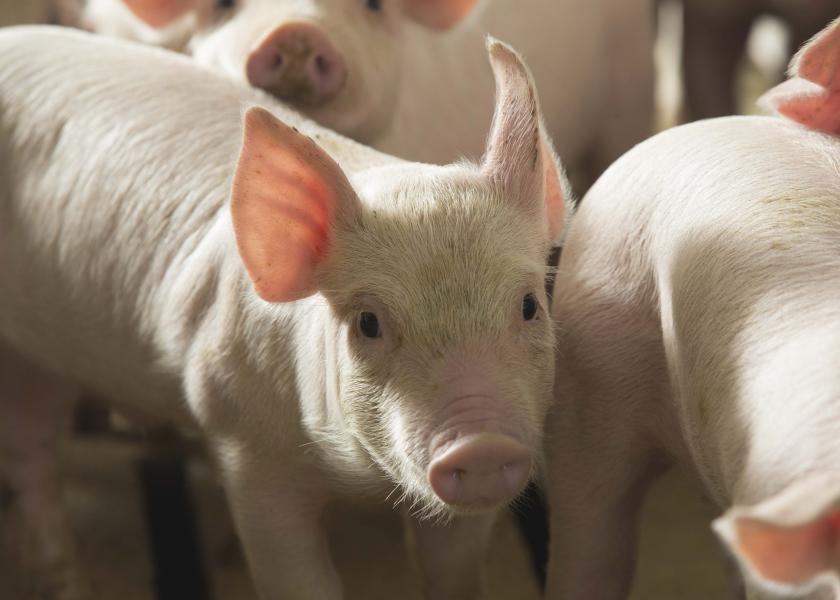Thriftiness is an Important Component of a Quality Weaned Pig

By JoAnn Alumbaugh
Every pig that enters the nursery has a foundational impact on an operation’s outcome, from a production as well as profit standpoint. The more quality weaned pigs that can be produced, the more positive the end result will be. Quality weaned pigs generally are healthy, consistent, thrifty, and have a good combination of age and weight.
Thriftiness can be described as a strong, robust piglet that is able to nurse, gain weight and transition to the nursery or wean-to-finish phase easily.
Mariana Boscato Menegat, PhD, swine nutritionist for Holden Farms in Northfield, Minn., says a pig is thrifty if it has the ability to maintain an expected growth rate and remain healthy. With about 70,000 sows, Holden Farms managers understand the importance of raising a quality weaned pig.
Healthy Sows First
“It starts with the sows,” says Menegat, who received her PhD from Kansas State University. “Taking care of the sow is a good way to be more efficient [at producing a thrifty weaned pig],” Menegat says. At Holden Farms, we manage sow body condition throughout gestation to make sure females are getting the proper amount of feed to support a pregnancy and are not too thin or too fat.
“The goal is to have the sow in ideal body condition at the end of gestation so by the time she farrows, she’s in a good condition that promotes feed intake and milk production,” she adds.
Uislei Orlando, PhD, led the nutrition team for 12 years in a large integrated company in Brazil. As global director of nutrition for PIC for the last 6 years, his previous experience serves him well. He agrees with Menegat that body condition is important.
“Everything that impacts the mother is going to impact the piglet,” he emphasizes. “We need to focus on the sow. If our sows have the right feed, nutrition and body condition, we won’t have as much need for creep feeders and milk replacers.”
Strategies for boosting health include maximizing colostrum production, working aggressively to eliminate the presence of disease and feeding pigs highly digestible diets, says Mike Tokach, PhD, a professor and swine nutrition specialist at Kansas State University.
“If you start with a low disease presence, and especially the bacterial diseases, you reduce the need for antibiotics,” Tokach says.
Maximize Colostrum Intake
Just as important is what happens before pigs are born, Tokach adds. Research suggests that the amount of food the sow is fed 2 or 3 days before it farrows makes a big difference.
“If we can increase a sow’s consumption shortly before she farrows, we increase the level of nutrients coming from that diet and going to the colostrum,” Tokach says.
“Colostrum is the first milk that the sow produces,” says Holden Farms’ Menegat. “It’s rich in immunoglobulins, which are essential for piglets’ health and survival because there’s no transfer of immunity from the sow to piglets during gestation. Colostrum is critical in the first 24 hours after birth and pigs need to receive 200 ml to 250 ml of colostrum. By ensuring sows are able to produce milk, and making sure pigs are in a warm, dry environment, you’re giving them the start they need.”
Producers should ensure piglets have ample production of high-quality colostrum, which can yield lifelong benefits, Tokach says.
“If a pig has low-level colostrum intake, its chances of survival out of the farrowing house are greatly diminished, and then its chances of having a disease problem in the nursery is also increased,” he adds.
“We know body condition really affects colostrum production,” Menegat says. “When sows are too thin or fat, they won’t produce as much colostrum as sows in ideal condition. The same goes for milk production throughout lactation.”
Nutritional Uptake
“Weaned pigs and grow-finish pigs have really changed in recent years,” says Wayne Cast, Nutrition Specialist with PIC. “They’re so much more efficient – it takes fewer pounds of feed to produce a pound of pork, so that pound of feed needs to be more nutrient-dense. They’re putting down less fat and more muscle, so they require more protein and amino acids.”
Balance is important, Cast says. In other words, the diets that maximize performance aren’t necessarily the ones that maximize profitability. Computer modeling can help producers determine the best diet for their pigs, based on input costs.
“We have extreme ingredient prices right now,” Cast says. “A producer in Tennessee is going to have higher corn and soybean costs than a producer in the Midwest. A good nutritionist is like a good referee – he doesn’t impede the flow of the game. It’s important to consider each producer’s market, ingredient costs, facilities and management capabilities.”
“The lactation diet is really important,” says Cast. “These sows are producing more than ever. Increasing feed intake is critical and proper body condition is part of that equation. Self-feeders are a great tool to help sows maximize their lactation-feed intake.
“A comfortable sow with proper body condition and access to ample feed and water will go a long way toward producing a quality weaned pig,” he adds.
Editor’s Note: Read more about producing a thrifty, quality weaned pig in Part 2 of this article.







